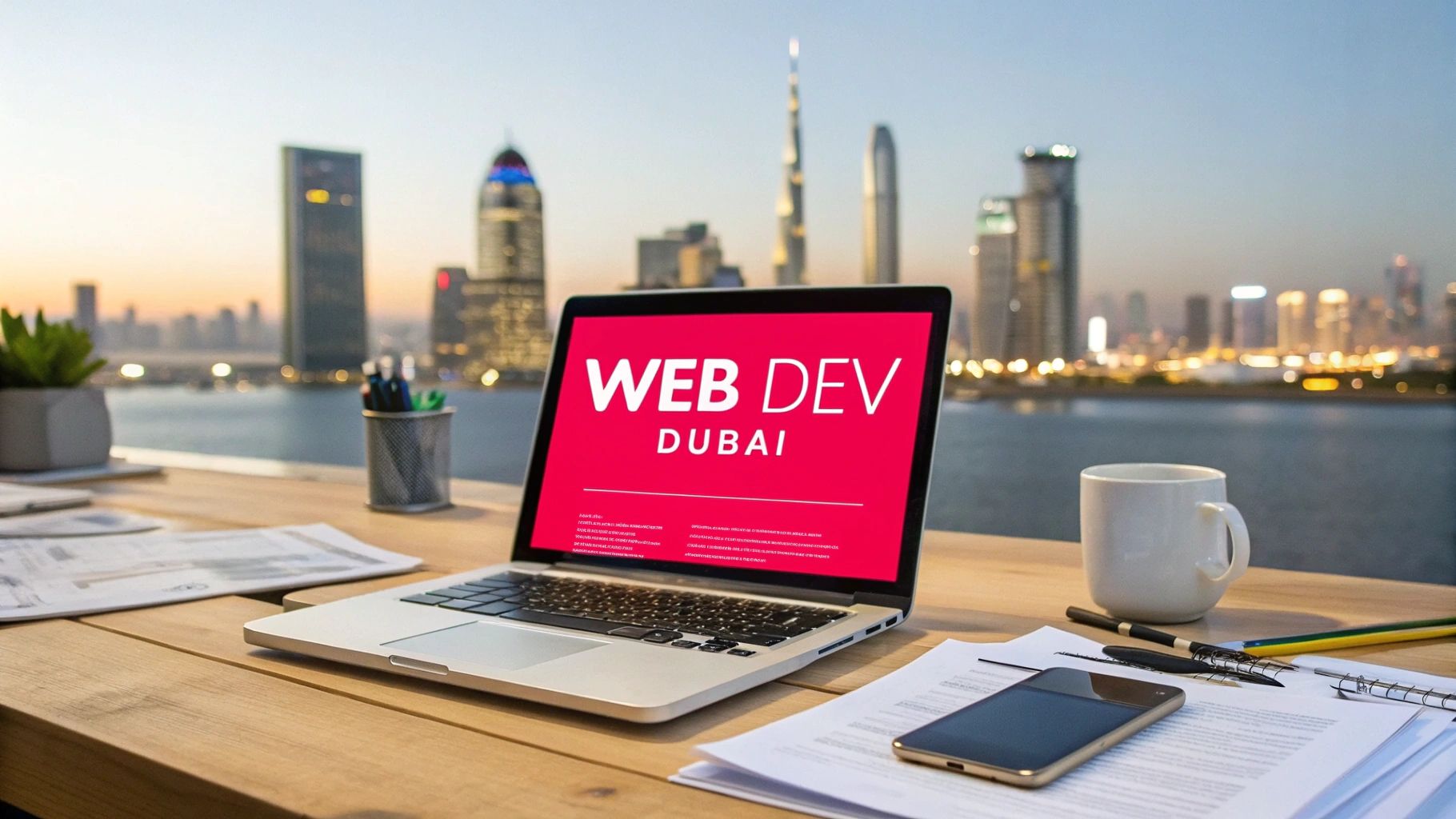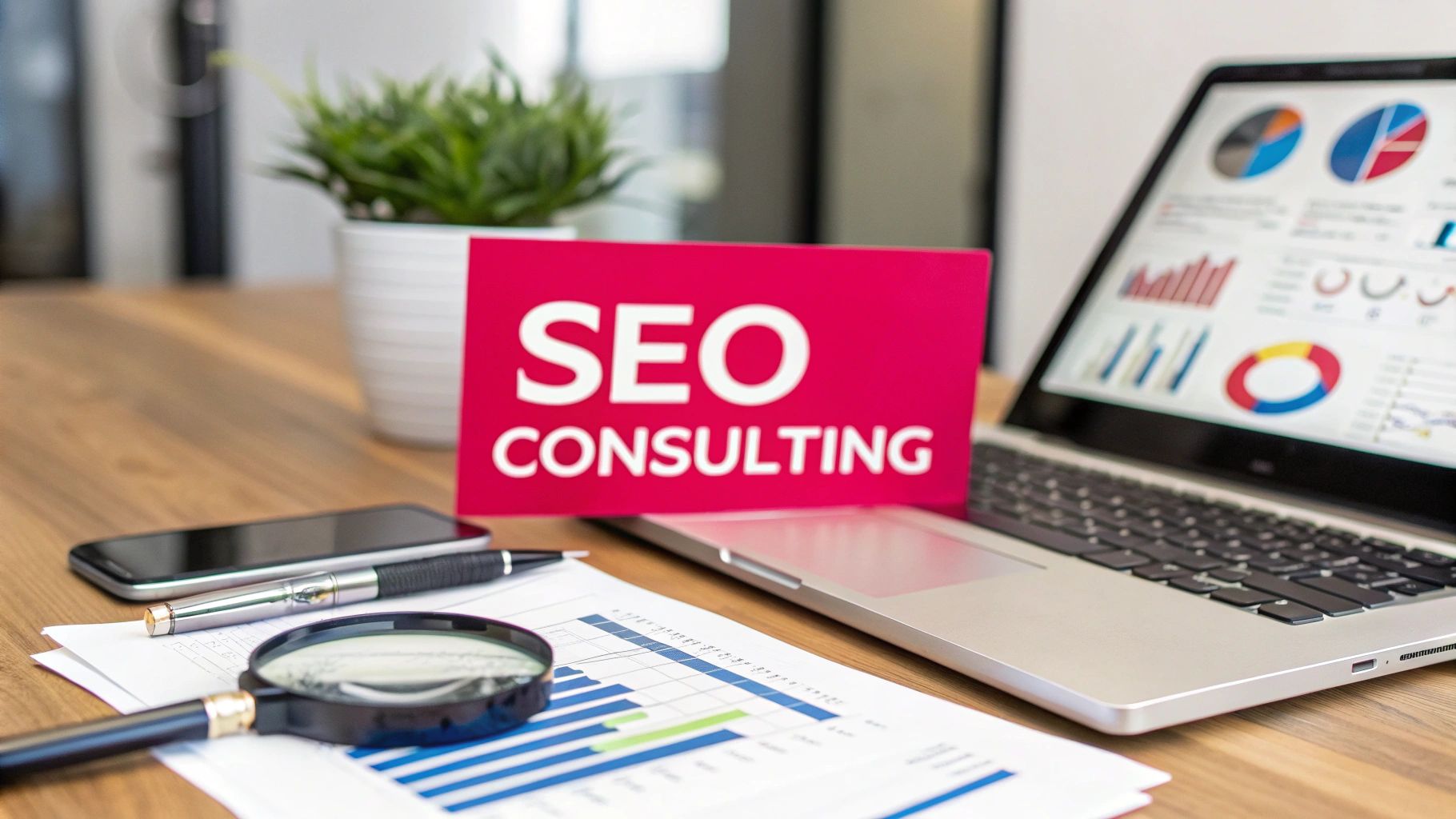Finding the right web development services in Dubai is about more than just building a website. It's about creating a powerful digital presence that truly connects with the local market. Working with a local agency gives you a home-field advantage, ensuring your site is not just technically flawless but also culturally tuned-in.
Why Dubai Is a Hub for Digital Innovation
Dubai’s transformation from a regional trading post to a global tech powerhouse has created an incredible demand for expert web development. We're not just talking about putting up basic websites anymore; this is about crafting digital experiences that capture the unique, fast-paced energy of the city.
This is why everyone, from nimble start-ups to huge multinational corporations, is looking for local agencies.
A Dubai-based team has a built-in understanding of the regional market dynamics, consumer habits, and cultural subtleties that an overseas firm just can't match. They get what makes the local audience tick.
This digital explosion is also fuelled by major government initiatives designed to build a world-class innovation ecosystem. The push towards creating a "smart city" has fast-tracked digital adoption everywhere, compelling businesses in retail, tourism, and finance to pour investment into their online platforms. It’s a strategic move central to the city's long-term economic goals. You can see how this affects business strategy in our guide on digital transformation consulting.
The Mobile-First Imperative
Here in the UAE, a mobile-first mindset isn't just a good idea—it's absolutely essential. People use their smartphones for everything, from shopping for groceries to booking five-star holidays. If your website isn't optimised for mobile, you're already behind.
A smooth, intuitive mobile experience is the bedrock of customer loyalty in Dubai's crowded digital marketplace. If your site is clunky or slow on a phone, you've lost that customer to a competitor in seconds.
The numbers don't lie. The vast majority of internet traffic here comes directly from mobile devices. This reality forces developers to build for the small screen first, ensuring sites are fast, easy to navigate, and look great on a phone. For any business serious about succeeding in Dubai, finding a web development partner who lives and breathes mobile-first design is the only way to build a lasting online presence.
Defining Your Project Vision and Goals
Before you even start looking for web development services in Dubai, you need to get your own house in order. A clear vision for your project isn't just a "nice-to-have"; it's the absolute blueprint for everything that follows. Without it, you're signing up for miscommunication, endless scope changes, and a final product that misses the mark on your actual business goals.
First things first: translate those big business ambitions into specific website goals. Are you trying to generate more qualified leads? Maybe you want to boost e-commerce sales by a specific percentage. Or perhaps the goal is to cement your brand as the go-to expert in your industry. Each one of these outcomes demands a completely different strategy.
From Business Goals to a Concrete Plan
To get from a fuzzy idea to a solid plan, you have to know exactly who you're building this for. Nailing down your target audience is non-negotiable. Think about their demographics, their online habits, and, most importantly, what problems they’re trying to solve when they land on your site.
Once you’ve got a clear picture of your ideal user, you can start mapping out their journey. How will they find you? What information are they desperately searching for? And what actions do you really want them to take? Sketching out these user journeys is the best way to figure out the essential features and content your website needs to actually work.
This visual shows the core flow for modern web projects, emphasising innovation and a mobile-first approach to achieve growth.
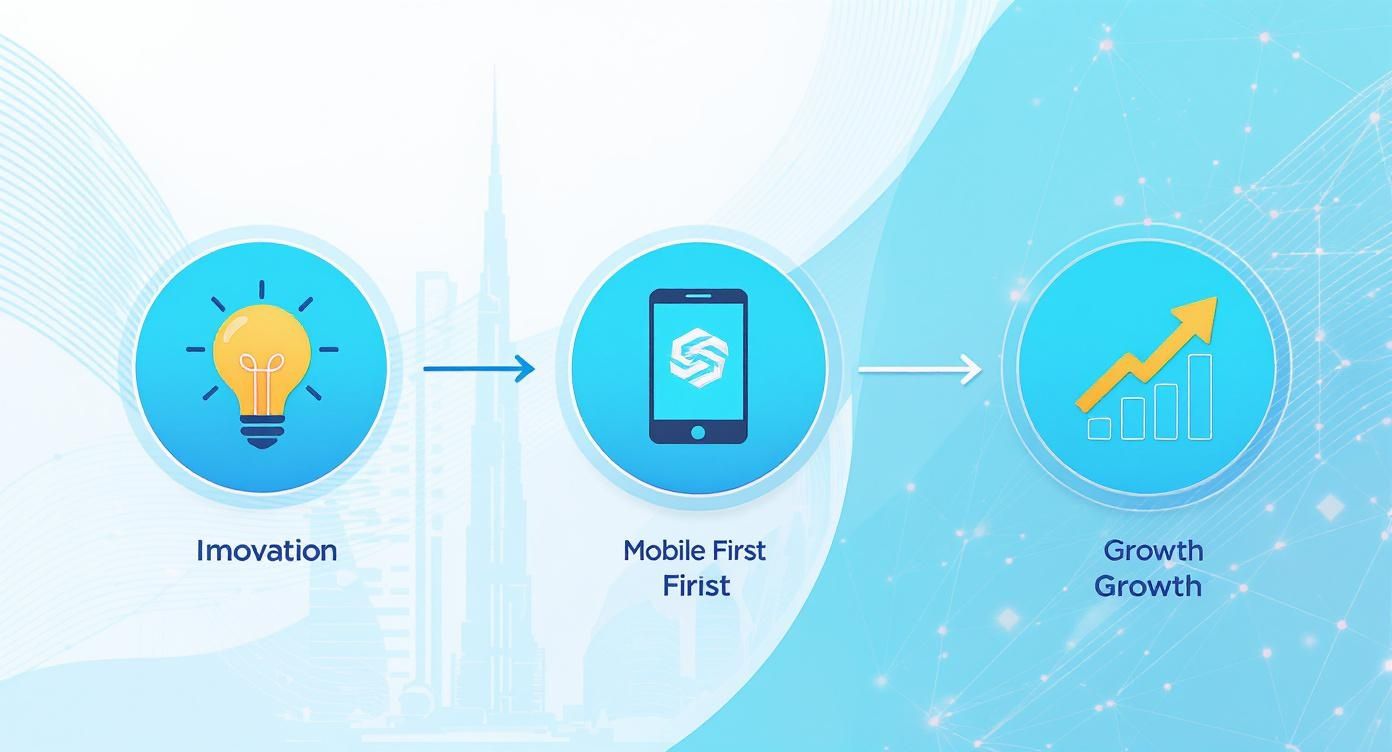
The real takeaway here is that a great digital strategy starts with a creative spark, gets built with today's mobile user front and centre, and is ultimately judged by the business growth it drives.
Creating Your Project Brief
A well-crafted project brief is your most valuable communication tool—period. It's what ensures potential development partners in Dubai actually get your vision and can come back with proposals that make sense. It needs to be detailed but not overwhelming.
Think of your project brief as a compass, not just a document. It aligns your internal team and any agency you talk to, making sure everyone is rowing in the same direction from day one.
A killer brief should lay out the following:
- Project Overview: A quick summary of your business and why you're building or redesigning this website right now.
- Key Objectives: Get specific and measurable. "Increase online sales by 25% in six months" is a world away from "sell more."
- Target Audience: Don't just say "millennials." Build out detailed personas of your ideal customers.
- Feature List: Make a prioritised list. What are the absolute 'must-haves' versus the 'nice-to-haves'? This is your best defence against scope creep and budget blowouts.
- Budget and Timeline: Be upfront. Providing a realistic budget range and a target launch date saves everyone a ton of time.
Armed with this level of clarity, you’re in a much stronger position to find a partner who won’t just build you a website, but the right website for your business.
Looking Beyond the Pretty Pictures: How to Judge Portfolios and Tech Skills

You’ve got a shortlist of potential agencies. Now, the real work begins. Their portfolio is where you separate the contenders from the pretenders. It's so easy to get wowed by flashy designs and slick animations, but a great-looking website that doesn't actually work for your business is just an expensive digital brochure.
Don’t just skim the homepages. You need to roll up your sleeves and actually use the websites they’ve built. Click around. Is it easy to find what you're looking for? How fast does it load? Pull it up on your phone – does it feel just as good, or is it a clunky, frustrating experience? This hands-on testing tells you more about their commitment to user experience (UX) than any polished presentation ever will.
The best portfolios show more than just pretty designs; they show results. Look for case studies with hard numbers. Did their work for a client result in a 45% jump in online leads or a significant boost in sales? That's the stuff that matters. It proves they get that a website is a business tool, not just a creative outlet.
Have They Done This Before? Gauging Industry Experience
Finding an agency that's already worked in your industry is like hitting the jackpot. A team that’s built successful e-commerce sites for other Dubai-based retailers already knows the landscape. They’ll be familiar with local payment gateways, customer expectations, and even the nuances of regional logistics. They won't be learning on your dime.
That kind of specialised experience makes the whole process smoother and leads to a much better outcome. As you're looking at web development services in Dubai, keep an eye out for portfolios featuring businesses like yours. If you run a B2B consultancy, an agency that only shows off flashy restaurant websites probably isn't the right partner, no matter how good their food photography looks.
A portfolio should be a collection of success stories. You're looking for an agency that has solved problems similar to yours, whether it's building a complex booking system, designing for high traffic, or achieving specific user engagement goals.
What’s Under the Hood? Making Sense of the Tech Stack
The technology an agency uses is the engine of your website. You don’t need to become a developer overnight, but knowing the basics will help you ask the right questions and make a smarter decision. The "tech stack" is simply the mix of programming languages, frameworks, and tools they use to build things.
Many businesses do perfectly well with platforms like WordPress or Shopify. They're fantastic for managing content and e-commerce stores. But what if your project needs something totally unique or has to handle massive amounts of traffic? That's when a custom solution using a framework like React or Laravel might be the answer.
This is where an agency's specialisation really comes into play. To help you figure out what makes sense for you, here’s a quick guide to some common tech stacks you’ll see.
Comparing Web Development Technology Stacks
The table below breaks down the most common technologies used by Dubai web development agencies. Use it to match a tech stack to your specific business needs and understand the trade-offs of each approach.
| Technology Stack | Best For | Pros | Cons |
|---|---|---|---|
| WordPress | Content-heavy sites (blogs, corporate), service businesses, portfolios | Huge community, vast plugin library, user-friendly CMS, highly customisable designs. | Can become slow if overloaded with plugins, requires regular security updates. |
| Shopify | E-commerce (from small shops to large retailers) | All-in-one platform, secure payment processing, excellent support, scalable for growth. | Transaction fees on non-Shopify payments, less customisation flexibility than custom solutions. |
| Custom (React, Laravel, etc.) | Web applications, platforms with unique features, high-performance sites | Total design freedom, unmatched performance and scalability, can be built to exact specifications. | Higher upfront cost, longer development time, dependent on the development team for maintenance. |
Understanding these distinctions helps you move beyond the sales pitch and have a real conversation about what's best for your project. You can ask an agency why they recommend a certain technology and be confident that their choice aligns with your goals.
For a deeper dive into what local experts are capable of, it's worth checking out this roundup of top website developers in the UAE to see the technologies they champion.
Understanding Web Development Costs in Dubai
Trying to get a straight answer on website costs in Dubai is a bit like asking, "How much for a car?" There’s no single price tag. A simple online brochure is worlds apart from a sprawling e-commerce marketplace, and the investment reflects that. The first step to setting a realistic budget is getting a handle on what actually drives the final cost.
The biggest variables are always the project's scope, the tech you choose to build with, and just how much custom work you need. A straightforward site using a template is one thing, but the moment you start adding unique features—like a custom booking engine, detailed user profiles, or complex software integrations—the complexity, and the cost, climb right along with it.
Breaking Down the Main Cost Drivers
When you get a quote from a development agency, you’ll see it’s not just one line item. It’s a blend of their team's expertise, the time they'll spend, and the resources needed to bring your vision to life.
Here’s a look at what shapes those numbers:
- Project Complexity: This is the big one. A five-page informational website is a much lighter lift than an enterprise-level platform with sophisticated back-end logic and different access levels for users.
- Technology Stack: Building on a platform like WordPress is generally more budget-friendly than a completely custom build using frameworks like React or Laravel. The key is making sure the tech aligns with where you want to take your business long-term.
- Custom Design vs Templates: A unique, from-scratch user interface (UI) and user experience (UX) will cost more than customising an off-the-shelf template. The trade-off? A bespoke design almost always creates a stronger brand identity and keeps users more engaged.
- Agency Expertise: It’s no surprise that a top-tier agency with a portfolio of successful projects and senior developers will charge more than a small, newer firm. You're not just paying for code; you're investing in their experience, reliability, and strategic thinking, which often saves you from costly missteps later on.
Dubai's position as a tech hub is clear from the investment flowing into its digital infrastructure. The UAE’s application development software market is expected to pull in around US$531.57 million in revenue by 2025. In this climate, a basic web project can start anywhere from AED 30,000–50,000, while more advanced solutions can easily top AED 200,000, with timelines ranging from eight to over 20 weeks. Apptunix offers a great detailed market analysis on these trends if you want to dig deeper.
Thinking Beyond the Initial Launch
I've seen it time and again: one of the most common budgeting mistakes is fixating only on the upfront build cost. Your website isn't a one-and-done project; it’s a living part of your business that needs regular attention to stay secure and perform well. If you're working with a tighter budget, our guide on affordable website design in Dubai has some practical tips.
A website launch is not the finish line; it’s the starting line. Factoring in ongoing costs from day one is essential for long-term success and avoiding unexpected financial strain down the road.
Make sure you set aside a budget for these often-forgotten expenses:
- Website Hosting: This is what keeps your site live on the internet. The cost depends on how much traffic you get and the performance you need.
- Domain Name Renewal: A small but necessary annual fee to keep your web address.
- Ongoing Maintenance: This is non-negotiable. It covers security updates, software patches, and fixing bugs to keep your site running smoothly and safe from threats.
- Future Updates and Features: Your business will evolve, and your website should too. Plan for adding new functions or content down the line so you’re not caught off guard.
Building a Website That Lasts

Think of your website as more than just a digital brochure; it’s a long-term asset that needs to grow with your business. To make sure it stays relevant and effective years down the line, you have to build it with the future in mind. That means picking technologies and strategies that can scale, adapt, and keep up with how people actually use the web.
When you're talking with potential partners for web development services in Dubai, push the conversation beyond the immediate look and feel. The real question is: how will this website handle growth? How will it integrate new features? And will it still perform when traffic spikes?
Keeping Pace with Next-Generation Web Tech
The web evolves at a blistering pace. What's standard today could be obsolete tomorrow. In Dubai's dynamic market, two trends you absolutely cannot ignore are Progressive Web Applications (PWAs) and voice search optimisation. These aren't just buzzwords; they represent a major shift in user behaviour.
Progressive Web Applications (PWAs) are expected to be a game-changer for user experience in 2025. They deliver a smooth, app-like experience right in the browser—they even work offline, which is a massive plus for keeping users engaged. At the same time, the explosion of smart speakers means optimising for voice search is non-negotiable. It makes you visible to a growing number of customers searching with their voice, often on the move.
Thinking about these advancements now puts you ahead of the curve. A future-ready website isn’t just about keeping up; it’s about building a lasting competitive edge.
Future-Proofing Your E-commerce Operations
If you're selling online, the checkout process is where everything comes together. A clunky or insecure payment system is the quickest way to kill a sale. As your business expands, your payment infrastructure must be ready to handle more transactions, different currencies, and emerging payment options without breaking a sweat.
A crucial part of this is choosing the best payment gateway for ecommerce that aligns with your specific business model and your customers' preferences.
A flexible and powerful payment gateway is the heart of a resilient e-commerce site. When evaluating your options, look for one that delivers on:
- Scalability: Can it process 100 orders a day just as smoothly as 10,000?
- Security: Does it offer top-tier fraud protection and meet the highest data security standards?
- Global Reach: Is it equipped to handle payments from your key international customer bases?
Building a website that truly lasts comes down to making smart choices from day one. By focusing on a scalable foundation, embracing new user trends, and prioritising security, you’re not just building a website—you're creating a digital asset that will pay dividends for years.
Launching Your Project Successfully
You’ve sifted through the proposals, scrutinised the portfolios, and have finally shaken hands with your chosen partner for web development services in Dubai. That’s a huge step forward, but the real work is just beginning. A smooth onboarding process is what truly cements a great partnership and sets the stage for the entire project.
Getting started on the right foot is all about translating those initial conversations and big ideas into a solid, actionable plan that everyone on both sides can get behind.
Setting the Ground Rules for Collaboration
Before anyone even thinks about writing a line of code, you need a rock-solid contract. Think of this document as the constitution for your project—it protects you, it protects the agency, and it prevents any misunderstandings later on.
Make sure your contract clearly defines:
- A Detailed Scope of Work: This should be an exhaustive list of every feature, page, and function you expect to be delivered. No ambiguity.
- Firm Timelines: Lay out the key milestones for design, development, testing, and the all-important launch date.
- Payment Schedule: A clear breakdown of payments that are tied directly to hitting those specific project milestones.
- Intellectual Property: This is crucial. The contract must state that you are the sole owner of the final code and all design assets once the project is complete and paid for.
Once the legal side is buttoned up, it's time to figure out how you'll talk to each other. Your agency will likely get you set up on a project management tool like Asana, Trello, or Jira. These platforms are indispensable for keeping everything in one place—from tracking progress to sharing files and feedback.
A successful project is built on collaboration, not just contracts. Clear communication and mutual respect are the real drivers of efficiency and innovation, turning a simple client-vendor relationship into a true partnership.
How to Be a Great Client
The agency has the technical know-how, but don't underestimate your own role in the project's success. Being a proactive, engaged partner makes a world of difference. That means providing feedback on designs and prototypes in a timely and consolidated manner—drip-feeding comments over several days can really slow things down.
Most importantly, trust the experts you hired. Your input is vital, of course, but giving them the creative and technical space to do their best work is essential. It's this collaborative spirit, from the first kickoff meeting right through to launch day, that makes the difference between a stressful project and a truly successful one.
Frequently Asked Questions
So, how long does it actually take to build a website in Dubai?
This is the classic "how long is a piece of string?" question, but I can give you some solid ballpark figures. For a straightforward, clean informational website, you're typically looking at a timeline of 4-6 weeks from start to finish.
However, if you're talking about a custom e-commerce platform with all the bells and whistles—unique features, complex integrations, the works—that's a different beast entirely. For something like that, you should realistically budget for 12-20 weeks, and sometimes even longer. The final timeline always hinges on things like the number of design revisions, the complexity of the features, and how quickly everyone provides feedback.
What's the real difference between web design and web development?
Think of it like building a house. Web design is the architect's job—it's all about the look, the feel, the user experience (UX). It covers the visual aesthetics, the layout, and how a visitor will navigate and interact with the site. It's the blueprint.
Web development is the construction crew. They take that beautiful blueprint and bring it to life, using code to build a fully functional, interactive website. It's the technical heavy lifting that makes everything work behind the scenes.
While they're separate disciplines, one is useless without the other. A stunning website that's broken is just a pretty picture. And a perfectly functional site that looks terrible will never connect with your audience. You need both to succeed.
Ready to build a digital presence that actually drives results? Grassroots Creative Agency specialises in creating bespoke websites that capture your brand's essence and achieve your business goals. Start your project with us today!
